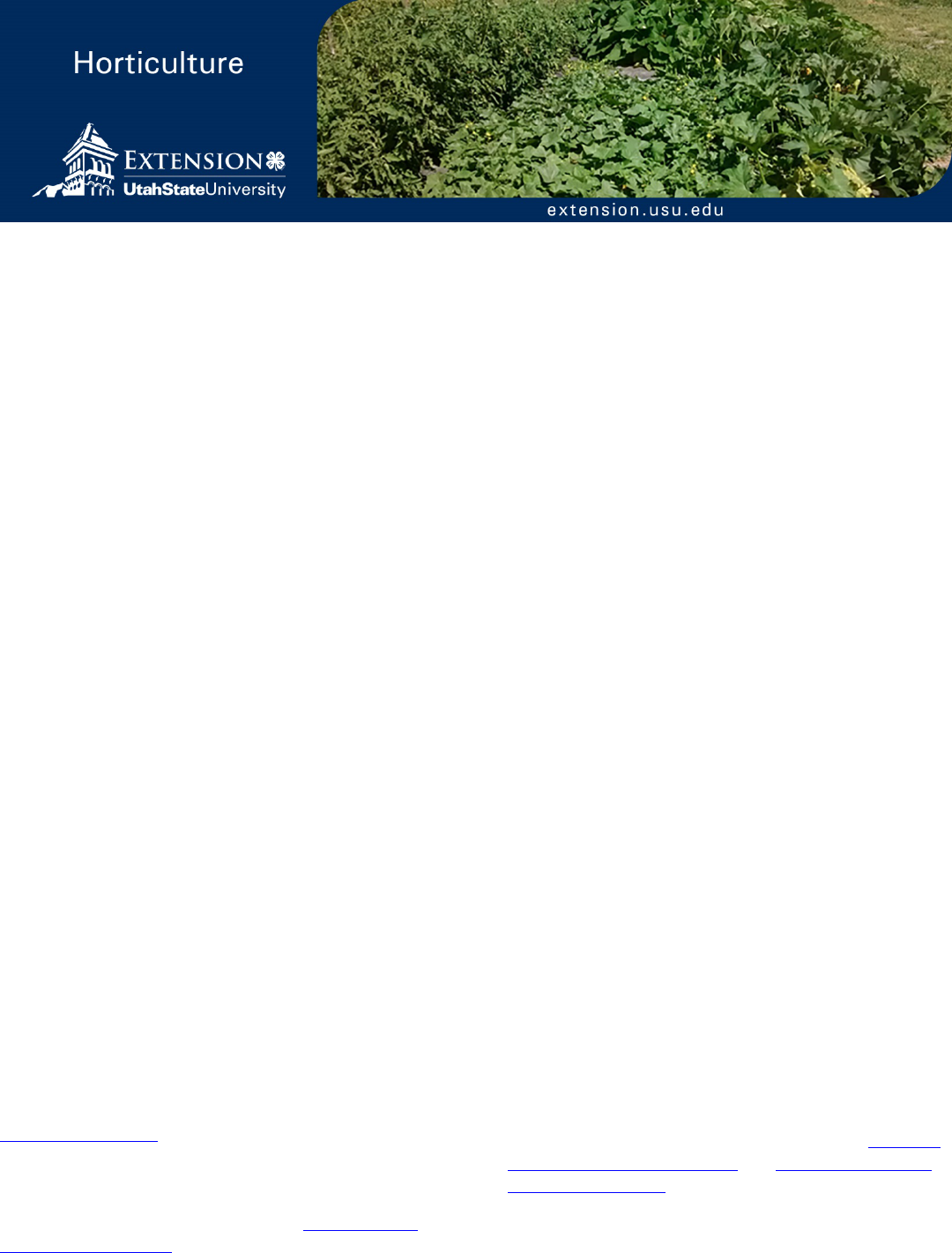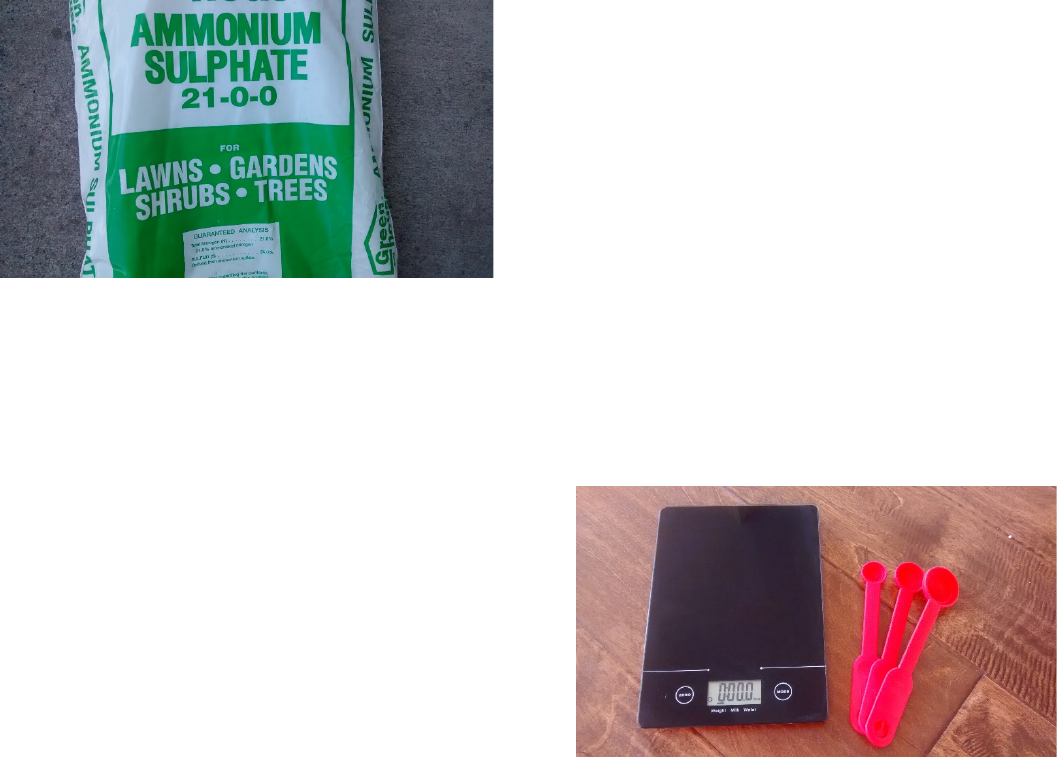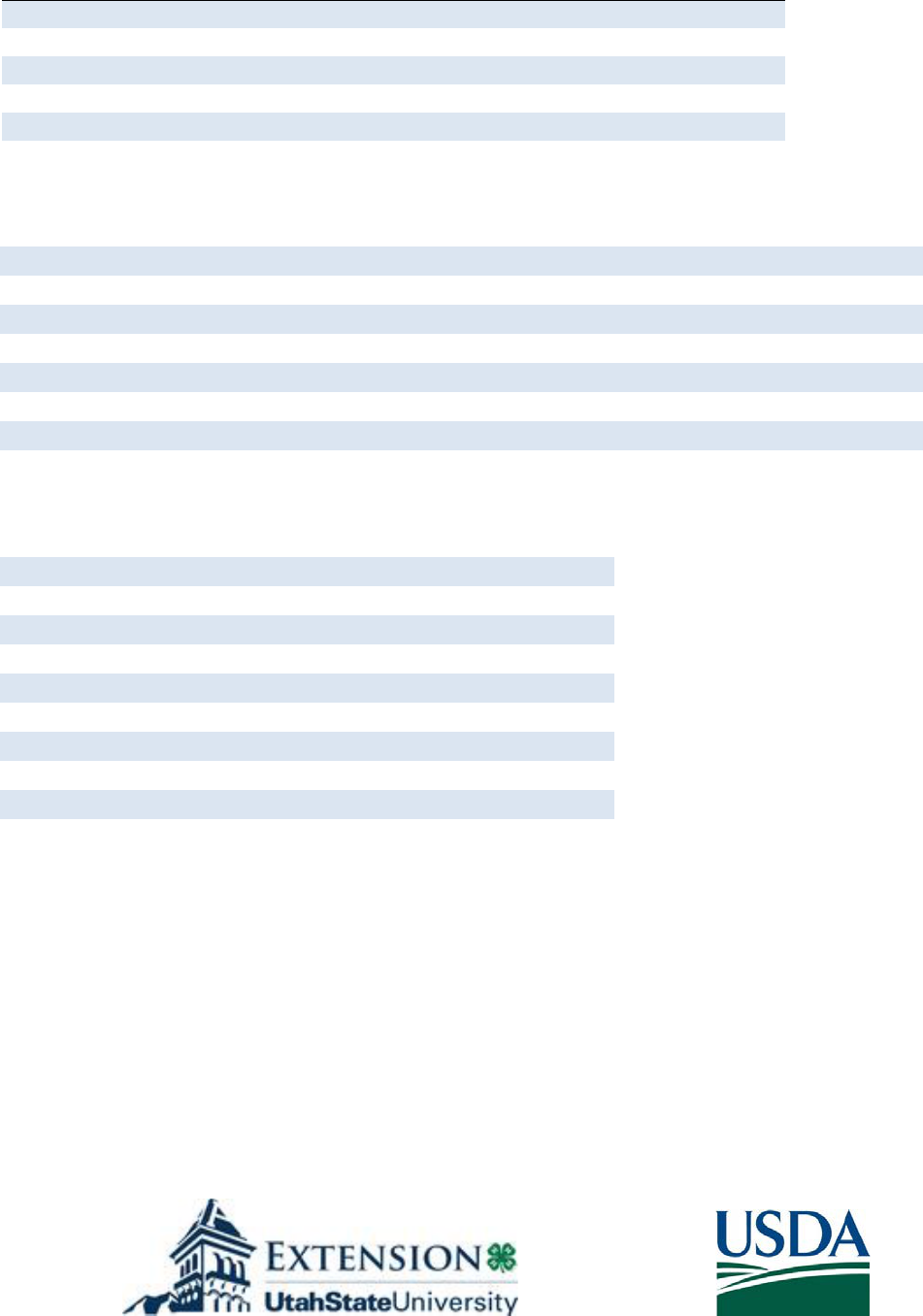
August 2016 Horticulture/Fertilizers/2016-01
Calculating Fertilizer for Small Areas
Tiffany Maughan, Grant Cardon, and Dan Drost
Introduction
Soil nutrients in the home landscape and garden may
become depleted over time. Replacing these nutrients
with fertilizers is often necessary. For some nutrients
(phosphorus or potassium), a single yearly application is
sufficient while with other nutrients (nitrogen) more
frequent applications are warranted. Knowing exactly
how much fertilizer to apply in your garden plot can be
challenging as fertilizer recommendations are typically
given for large areas (i.e., pounds per acre or per 1000
square feet). Gardeners and urban farmers often must
convert these recommendations to much smaller areas,
sometimes just a few square feet or even for a single
container or pot. Guessing at amounts to apply often
results in over or under fertilizing. Over fertilizing can
lead to ground water contamination, negatively impact
plant growth, and wastes money. Under fertilization
results in decreased plant health and reduced yields. This
fact sheet is meant to help gardeners convert fertilizer
recommendations to fit their individual garden plot size.
Four Steps for Successful Fertilizer
Application
1. Soil test. Start with having a soil test done on the area
you will be growing in. This is particularly important
when cultivating a new location, but should also be done
once every few years in an established garden or if you
are noticing decreased productivity. Utah State
University Analytical Labs is open to the public and
offers a wide variety of soil tests. Visit
http://usual.usu.edu/
for a complete list of tests offered,
pricing information and directions for collecting a soil
sample. Once you get your soil test results, correct
interpretation is important. If you are having difficulty
interpreting your results, the fact sheet
Understanding
Your Soil Test Report provides a helpful explanation.
Table 1 shows a sample soil test report for the most
basic test offered from the USU Analytical Lab,
reporting soil texture, pH, salinity, phosphorous, and
potassium. Soil nitrogen is not reported but a general
recommendation is still given.
2. Deciding how much to apply. You will need to know
the square footage of the area to be fertilized. Table 2
shows various formulas that can be used to calculate the
square footage of your garden.
Once you know your garden’s square footage and have
the fertilizer recommendations from your soil test,
calculate the number of pounds of each nutrient needed
using the following equation.
Pounds recommended per 1000 sq ft X Square
Footage/1000 sq ft = Pounds to apply in garden
Based on your soil test results, determine which
nutrients you need to apply. Usually, in vegetable
gardens and lawns, nitrogen needs to be applied every
year. If you do not have a soil test, a general
recommendation for a vegetable garden is to apply 2 to 4
pounds of nitrogen per 1000 square feet.
3. Deciding which fertilizer to apply. There are many
different fertilizer options that provide nutrients to the
soil. All the different choices can be very overwhelming
and leave homeowners confused about what they should
actually apply. There are two main groups of fertilizers:
organic and inorganic (sometimes referred to as
chemical) fertilizers. Both types, if properly used, are a
good option for homeowners. The fact sheets,
Selecting
and Using Organic Fertilizers and Selecting and Using
Inorganic Fertilizers provide useful information on both
types of fertilizer as well as lists of fertilizer nutrient
content in each type.

Example: 10 by 20 foot garden and 2 pounds per
1000 square feet nitrogen recommendation
10 x 20 =200 square feet
2 lbs N x (200 sq ft/1000) = 0.4 pounds
nitrogen applied over total garden area
All fertilizers sold commercially must be labeled with a
standardized label. The label will have 3 numbers,
separated by dashes, indicating the percentage of three
major nutrients: nitrogen (N), phosphate (P
2
O
5
), and
potash (K
2
0). As an example, a common starter fertilizer
is 20-27-5. That means it contains 20% nitrogen, 27%
phosphate, and 5% potash. To calculate how many
pounds of each nutrient in your fertilizer bag, multiple
the weight of the bag by the percentage of each nutrient.
Example: 5 pound bag of 20-27-5 fertilizer
Nitrogen: 5 lbs fertilizer x 20% (0.20) = 1 pound
N
Phosphate: 5 lbs fertilizer x 27% (0.27) = 1.35
pounds Phosphate
Potash: 5 lbs fertilizer x 5% (0.05) = 0.25 pound
Potash
Other nutrients, such as zinc, magnesium, iron or copper
can also be purchased in a fertilizer but will be specified
elsewhere on the label. Table 3 lists single nutrient
fertilizers.
From our example above, the garden requires 0.4 lbs of
nitrogen. If you are using the 20-27-5 fertilizer sources,
you would apply 2 lbs (0.4 lbs. N / 0.20 (20% N) = 2) of
that fertilizer over the 200 sq. ft. garden. Since the soil
test (Table 1) indicated low P and high K applying a 20-
27-5 fertilizer is an acceptable option. However, one
without any K would be better.
When choosing a fertilizer material, application of only
those nutrients needed (as dictated by soil test results) is
advised to protect against unnecessary accumulation of
excess nutrients in the soil. Excess amounts of P and K
are not toxic to plants, but can have secondary
environmental effects on surface water quality (e.g., P in
runoff) and soil and water salinity (e.g., high K
accumulation). Over-application of N is a serious issue
that can have a detrimental effect on plant growth, and
also presents potential undesirable environmental effects
such as nitrate contamination of ground water.
Additionally, N in surface water contributes to algal
blooms that deplete oxygen for fish and other aquatic
organisms. Furthermore, excess P in soils can present
competitive uptake restriction over minor, but often
limiting nutrients such as iron (Fe) and zinc (Zn).
Finding one fertilizer that perfectly meets your soil test
recommendation is not always possible; combining
different single-nutrient fertilizers (Table 3) may be the
best option for your situation.
4. Measuring the correct amount. When working with
backyard gardens, flower beds or patio boxes the amount
of fertilizer needed is typically fairly small. Conversions
to smaller measurements are often needed. Table 4 and 5
have useful conversions for various measurements. To
take some of the guesswork out of measuring, consider
investing in some simple tools that will improve
accuracy. A small kitchen scale and a set of measuring
cups and spoons that can be dedicated to fertilizer
applications will prove useful.
Case Study
Table 1 is a sample garden report for the most basic test
offered from the USU Analytical Lab. It recommends
the gardener apply 2 to 4 pounds N per 1000 square feet,
1 to 2 pounds P
2
O
5
per 1000 square feet, and 0 pounds
K
2
O per 1000 square feet and. The area to be fertilized is
200 square feet.
Calculations for each of the three nutrients follow.
Pounds recommended per 1000 sq ft X Square
Footage/1000 sq ft = Pounds to apply in area
Nitrogen:
2 lbs N X (200 sq ft/1000 sq ft) = 0.4 lbs N
to
4 lbs N X (200 sq ft/1000 sq ft)
= 0.8 lbs N

Phosphate:
1 lbs P
2
O
5
X (200 sq ft/1000 sq ft) = 0.2 lbs
P
2
O
5
to
2 lbs P
2
O
5
X (200 sq ft/1000 sq ft)
= 0.4 lbs P
2
O
5
Potash:
0 lbs K
2
O X (200 sq ft/1000 sq ft) = 0 lbs K
2
O
Table 1. Sample soil test report from USUAL.
Table 2. Formulas for calculating square footage of variously shaped areas.
Shape
Formula
Square or rectangle
Area = Length x Width
Triangle
Area = 1/2 x Base x Height
Circle
Area = 3.14 x radius2
Ovals (5% accuracy)
Area= Length x Width at midpoint x 0.8
Irregular shapes (5% accuracy)
Measure longest axis of area (length)
At every 10 ft on the length line measure the width
Total all widths and multiply by 10
Area = (A + B + C + D + E) x 10
See companion Excel workbook at
http://digitalcommons.usu.edu/extension_
curall/1582/
to enter in your exact specifications and get
nutrient recommendations that fit your
needs. The workbook will walk you through
calculating fertilizer amounts.

Table3. Single source fertilizers.
Fertilizer
N-P-K
Urea
46-0-0
Ammonium nitrate
34-0-0
Ammonium sulfate
21-0-0
Triple superphosphate
0-45-0
Potassium chloride
0-0-60
Table 4. Equivalents for volume measurements
Gallons
Quarts
Pints
Fluid Ounces
Cups
Tablespoons
Teaspoon
Milliliters
Liters
1
4
8
128
16
256
768
3785
3.785
-
1
2
32
4
64
192
946
0.946
-
-
1
16
2
32
96
473
0.473
-
-
-
1
1/8
2
6
30
0.03
-
-
-
-
1
16
48
236
0.236
-
-
-
-
-
1
3
15
0.015
-
-
-
-
-
-
1
5
0.005
-
-
-
-
-
-
-
1
0.001
Table 5. Rate of application equivalent table (dry materials)
Per Acre
Per 1,000 sq ft
Per 100 sq ft
Per 10 sq ft
1 lb
2.5 tsp
0.25 tsp
0.025 tsp
3 lbs
2.25 tbs
0.75 tsp
0.075 tsp
4 lbs
3 tbs
1 tsp
0.10 tsp
5lbs
4 tbs
1.25 tsp
0.13 tsp
10 lbs
0.4 cup
2 tsp
0.2 tsp
100 lbs
2.25 lbs
0.25 lb
2.4 tsp
200 lbs
4.66 lbs
0.5 lb
1.6 tbs
300 lbs
7 lbs
0.75 lb
2.4 tbs
400 lbs
9.25 lbs
1 lb
3.2 tbs
500 lbs
11.5 lbs
1.15 lbs
4 tbs
This project is funded in part by USDA-Risk Management Agency under a cooperative agreement. The information reflects the views
of the author(s) and not USDA-RMA.
Utah State University is committed to providing an environment free from harassment and other forms of illegal discrimination based
on race, color, religion, sex, national origin, age (40 and older), disability, and veteran’s status. USU’s policy also prohibits
discrimination on the basis of sexual orientation in employment and academic related practices and decisions. Utah State University
employees and students cannot, because of race, color, religion, sex, national origin, age, disability, or veteran’s status, refuse to hire;
discharge; promote; demote; terminate; discriminate in compensation; or discriminate regarding terms, privileges, or conditions of
employment, against any person otherwise qualified. Employees and students also cannot discriminate in the classroom, residence
halls, or in on/off campus, USU-sponsored events and activities. This publication is issued in furtherance of Cooperative Extension
work, acts of May 8 and June 30, 1914, in cooperation with the U.S. Department of Agriculture, Kenneth L. White, Vice President for
Extension and Agriculture, Utah State University.
